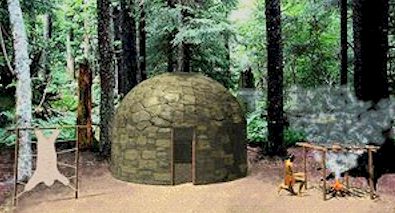Although as was discussed in an earlier article on the Apache wickiup, some indigenous tribes still lived in very primitive shelters up until the late 1800s, most had long developed larger, sturdier houses that could be heated in the winter. One of the most common types of native houses in the Midwest and New England was the wigwam. It had obviously evolved from the wickiup type shelter, but was far more spacious and durable. A buffalo or bear skin door could seal the opening to block cold winds and rains. It was large enough for occupants to stand or build a fire. Some wigwams could hold up to 20 occupants. Yet, its light woven sapling framework enabled native peoples to dismantle the structure and transport it long distances between seasonal camps.
Variations of the wigwam were probably built throughout North America from 4000 to 1000 years ago. As some native societies in the Southwest and Southeast became more sedentary due to increased dependence on agriculture, they developed larger, more permanent types of housing.
The arch was the structural principal that made the light weight wigwam so durable. Its builders would first sketch out an oval shape on the ground. Then green saplings were pushed into the ground and bent until they overlapped with saplings from the opposite edge of the oval. The overlapped saplings were then tied with twine or leather thongs to form arches. Then, other saplings were place parallel with the ground and tied to the vertical arches. These horizontal saplings are called purlins. The wigwams builder would then strip large sections of bark from such trees as the birch or elm to make roof shingles. The bark shingles were then tied to the sapling framework. Finally, more vertical sapling were pushed into the ground, outside the bark shingles and tied together. The outer sapling arches held down bark shingles in the wind. A hole would be left at the top of the main wigwam roof to allow smoke to escape.
Although the wigwam was used year round in what is now the lower Midwest, Mid-Atlantic states, Virginia and Carolinas, it was not as suitable for the extremely cold climate of the upper Great Lakes region and northern Plains. Tribes in these regions moved to double-lined teepees during the winter months. The animal skins of the teepee completely blocked the cold winter winds.


